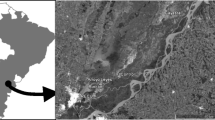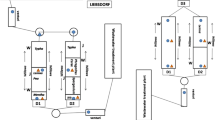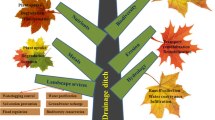Abstract
Supplying polluted river water to nature reserves in The Netherlands often leads to eutrophication of the reserve. The eutrophication can be caused directly by the high nutrient input (external eutrophication) or indirectly by altering nutrient availability due to changes in nutrient desorption or mineralization. This paper investigates the potential of a ditch system that is tested for its potential to improve the water quality of polluted river water prior to supplying to the wet meadow reserve De Meije in The Netherlands. Concentrations of the macro-ions chloride, sulphate, calcium and bicarbonate in the polluted river water were much higher than original background values, measured in the reserve. During transport of the river water through the ditch system, no decline was observed in the concentrations of these macro-ions. The phosphorus concentration, however, decreased along the flow path and was significantly negatively correlated with the distance from the inlet point. High phosphorus removal occurred in a stretch of the ditch system where submerged and free floating species such as Fontinalis antipyretica and Lemna trisulca were dominant. The N: P ratio of F. antipyretica was especially low (N : P < 5) at sampling stations where high phosphorus concentrations were measured. The high N: P ratio indicated a luxury consumption of phosphorus. With decreasing phosphorus concentrations, the N: P ratio of F. antipyretica increased to a maximum of N: P = 25. The nutrient budget of the ditch system showed that supply of river water was the main input of phosphorus (12 kg P) whereas the main inputs of nitrogen of the ditch system were atmospheric deposition (66 kg N) and leaching from the wet meadows (44 kg N). For both nutrients, harvesting the aquatic vegetation in September was the main removal mechanism from the ditch system with 92 kg of nitrogen (80% of the annual input N) and 14 kg of phosphorus (95% of the annual P input) removed. It was concluded that the ditch system with aquatic vegetation could successfully remove nutrients from polluted river water. The concentrations of macro-ions, however, are not influenced by the ditch systems and internal eutrophication due to changes in adsorption or mineralization may still occur.
Similar content being viewed by others
References
Van Aalst R.M. 1984. Depositie van verzurende stoffen in Nederland. In: Adema E.H. and van Ham J. (eds), Zure Regen - Oorzaken, Effecten en Beleid, Vereniging Lucht Pudoc Publishers, Wageningen, The Netherlands.
Beltman B. and van der Krift T. 1996. De invloed van sulfaat en chloride op de fosfaatbeschikbaarheid in veenbodems; een bijdrage aan integraal waterbeheer. H2O 301/97): 19–21.
Berhane D. 1988.Hydrologisch Onderzoek in de Schraallanden Langs De Meije. Directie NMF, Consulentschap Utrecht and SBB/WBL, 20 pp.
Bloemendaal F.H.J.L. and Roelofs J.G.M. (eds), 1988. Waterplanten en Waterkwaliteit. Stichting Uitgeverij Koninklijke Nederlandse Natuurhistorische Vereniging, nr. 45, Utrecht, The Netherlands, 189 pp.
Caraco N.F., Cole J.J. and Likens G.E. 1989. Evidence for sulphate-controlled phosphorus release from sediments of aquatic systems. Nature 341: 316–318.
Denny P. 1987. Mineral cycling by wetland plants - A review. Archiv für Hydrobiolgie Beih 27: 1–25.
Downing J.A. and McCauley E. 1992. The nitrogen: phosphorus relationship in lakes. Limnology and Oceanography 37: 936–945.
Erisman J.W. 1992. Atmospheric Deposition of Acidifying Compounds in The Netherlands. Ph.D. Thesis, Utrecht University, The Netherlands.
Freeze R.A. and Cherry J.A. 1979. Groundwater. Prentice-Hall Publishers, 604 pp.
Graneli W. and Solander D. 1988. Influence of aquatic macrophytes on phosphorus cycling in lakes. Hydrobiologia 170: 245–266.
Grootjans A.P. 1985. Changes in Groundwater Regime in Wet Meadows. Thesis Rijksuniversiteit, Groningen, The Netherlands.
Jansen A.J.M. and Roelofs J.G.M. 1996. Restoration of Cirsio-Molinietum wet meadows by sod cutting. Ecological Engineering 7: 279–298.
Kadlec R.H. 1990. Modelling nutrient behaviour in wetlands used for wastewater treatment. In: Oorschot M.M.P. and Verhoeven J.T.A. (eds), Moerassen voor de Zuivering van Water. PAO-cursus. The Utrecht Plant Ecology News Report 11, Utrecht University, The Netherlands, pp. 104–129.
Kadlec H. and Knight R.L. 1996. Treatment Wetlands. CRC Press Inc., Boca Raton, Florida, USA.
Koerselman W. and Beltman B. 1988. Evapotranspiration from fens in relation to Penman’s potential free water evaporation (E 0 ) and pan evaporation. Aquatic Botany 31: 307–320.
Koerselman W. 1989a. Hydrology and Nutrient Budgets of Fens in an Agricultural Landscape. Ph.D Thesis, Utrecht University, The Netherlands.
Koerselman W. 1989b. Groundwater and surface water hydrology of a small groundwater fed fen. Wetland Ecology and Management 1: 31–43.
Koerselman W. 1990. Bepaling van de efficientie van moerassen met betrekking tot verwijdering van nutriënten. In: Oorschot M.M.P. and Verhoeven J.T.A. (eds), Moerassen voor de Zuivering van Water. PAO-cursus, The Utrecht Plant Ecology News Report 11, Utrecht University, The Netherlands, pp. 22–43.
Koerselman W. and Verhoeven J.T.A. 1993. Eutrofiëring van laagvenen: interne of externe oorzaken? Landschap 10: 31–44.
Koerselman W., van Kerkhoven M.B. and Verhoeven J.T.A. 1993. Release of inorganic N, P and K in peat soils; effect of temperature, water chemistry and water level. Biogeochemistry 20: 63–81.
Koerselman W. and Meuleman A.F.M. 1995. Predicting the nature of nutrient limitation from the N: P ratio of plants; a new tool for the restoration of eutrophicated ecosystems. Journal of Applied Ecology 33: 1441–1450.
Lamers L.P.M., Tomassen H.B.M. and Roelofs J.G.M. 1998. Sulfate induced eutrophication and phytotoxicity in fresh-water wetlands. Environmental Science and Technology 32: 199–205.
Langeland K.A., Sutton D.L. and Canfield D.E. Jr. 1983. Growth response of Hydrilla to extractable nutrients in prepared substrates. Journal Freshwater Ecology 2: 263–272.
De Lyon M.J.H. and Roelofs J.G.M. 1986. Waterplanten in relatie tot waterkwaliteit en bodemgesteldheid. Rapporten Landirnichtingsdient/Laboratorium voor Aquatische Oecologie. Katholieke Universiteit, Nijmegen, The Netherlands.
Meuleman A.F.M., de Bruin H. and Beltman B. 1990. The use of vegetated ditches for water quality improvement; a tool for nature conservation in wetland areas. In: Cooper P.F. and Findlater B.C. (eds), Constructed Wetlands in Water Pollution Control. Advances in Water Pollution Control, Pergamon Press, Oxford, UK, pp. 599–602.
Meuleman A.F.M., Beltman B. and Scheffer R.A. 1996. Aanvoer van gebiedsvreemd water. Probleem of oplossing voor natte natuur in het veenweidegebied. Landschap 1996(3): 181–192.
Meuleman A.F.M. 1999. Performance of Treatment Wetlands. Ph.D. Thesis, Utrecht University, The Netherlands, 113 pp.
Moshiri G.A. (ed.) 1993. Constructed Wetlands for Water Quality Improvement. Lewis Publishers, Boca Raton, USA.
Mueller-Dombois D. and Ellenberg H. 1974. Aims and Methods of Vegetation Ecology. Wiley, New York, USA.
Nature Conservation Council, 1992. Stilstaan bij water. Advies over gebiedseigen water. Natuurbeschermingsraad, Utrecht, The Netherlands.
Ower J., Cresswell C.F. and Bate G.C. 1981. The effects of varying culture nitrogen and phosphorus levels on nutrient uptake and storage by the water hyacinth Eichornia crassipes. Hydrobiologia 85: 17–22.
Reddy K.R. and De Busk W.F. 1987. Nutrient storage capabilities of aquatic and wetland plants. In: Reddy K.R. and Smith W.H. (eds), Aquatic Plants for Water Treatment and Recovery, Magnolia Publishing Company, Orlando, Florida, USA, pp. 337–357.
Richardson C.J. 1989. Freshwater wetlands: transformers, filters or sinks. In: Sharitz R.R. and Gibbons J.W. (eds), Freshwater Wetlands and Wildlife, CONF 8603101, DOS Symposium Series No. 61, USDOS Office of Scientific and Technical Information, Oak Ridge, USA.
Richardson C.J., Qian S.S., Craft C.B. and Qualls R.G. 1997. Predictive models for phosphorus retention in wetlands. Wetlands Ecology and Management 4: 159–175.
Richardson C.J. and Qian S.S. 1999. Long-term phosphorus assimilative capacity in freshwater wetlands: A new paradigm for sustaining ecosystem structure and function. Environmental Science and Technology 33: 1545–1551.
Ridder T.B., Baard J.H. and Buishand T.A. 1984. The impact of sample strategy and analysis protocol on concentrations in rainwater, KNMI De Bilt, Report TR-55, The Netherlands.
Roelofs J.G.M. 1991. Vegetation under Chemical Stress. Ph.D. Thesis, University of Nijmegen, The Netherlands.
Rossenaar A.J. 1990. Vegetatiekartering Schraallanden langs de Meije. Staatsbosbeheer, Driebergen, The Netherlands, 81 pp.
Scheffer R.A. 1992. De relatie tussen de nutriëntensamenstelling van het oppervlaktewater en de watervegetatie in de schraallanden langs de Meije. Doctoraalverslag Vakgroep Botanische Oecologie en Evolutiebiologie, Utrecht University, The Netherlands.
Seidel K. 1976. Macrophytes and water purification. In: Tourbier J. and Pierson R.W. (eds), Biological Control of Water Pollution. University of Pennsylvania Press, USA, pp. 109–121.
Solksi A. 1962. Mineralization of aquatic vegetation. I. Liberation of phosphorus and potassium salts by leaching. Pol. Archiv. Hydrobiologie 10: 167–196.
Stuyfzand P.J. 1996. Hydrochemistry and hydrology of the coastal dune area of the Western Netherlands. Ph.D. Thesis, Kiwa Research and Consultancy, Nieuwegein, The Netherlands.
Stumm W. and Morgan J.J. 1981. Aquatic Chemistry. John Wiley and Sons Inc., New York, USA.
Verhoeven J.T.A. and Meuleman A.F.M. 1999. Wetlands for wastewater treatment: Opportunities and limitations. Ecological Engineering 12: 5–12.
De Vries J.J. 1980. Inleiding tot de Hydrologie van Nederland. Rodopi, Amsterdam, The Netherlands.
Westhoff V. and Den Held A.J. 1975. Plantengemeenschappen in Nederland. Thieme, Zutphen, The Netherlands.
Widdel F. 1988. Microbiology and ecology of sulphate-and sulfur-reducing bacteria. In: Zehnder A.J.B. (ed.), Biology of Anaerobic Micro-Organisms, John Wiley and Sons, New York, USA.
Author information
Authors and Affiliations
Rights and permissions
About this article
Cite this article
Meuleman, A.F.M., Beltman, B. & Scheffer, R.A. Water pollution control by aquatic vegetation of treatment wetlands. Wetlands Ecol Manage 12, 459–471 (2004). https://doi.org/10.1007/s11273-004-1389-7
Revised:
Issue Date:
DOI: https://doi.org/10.1007/s11273-004-1389-7




